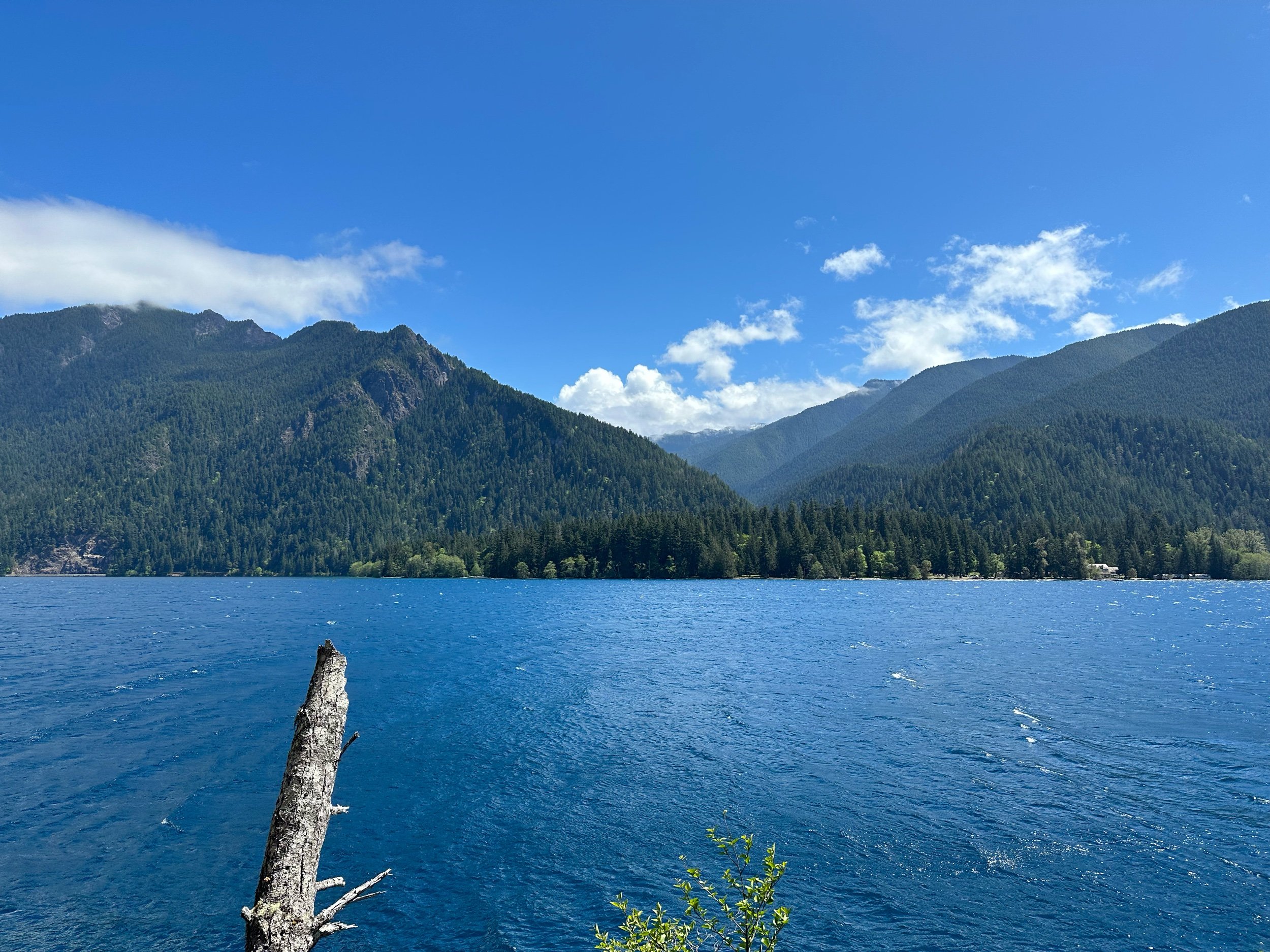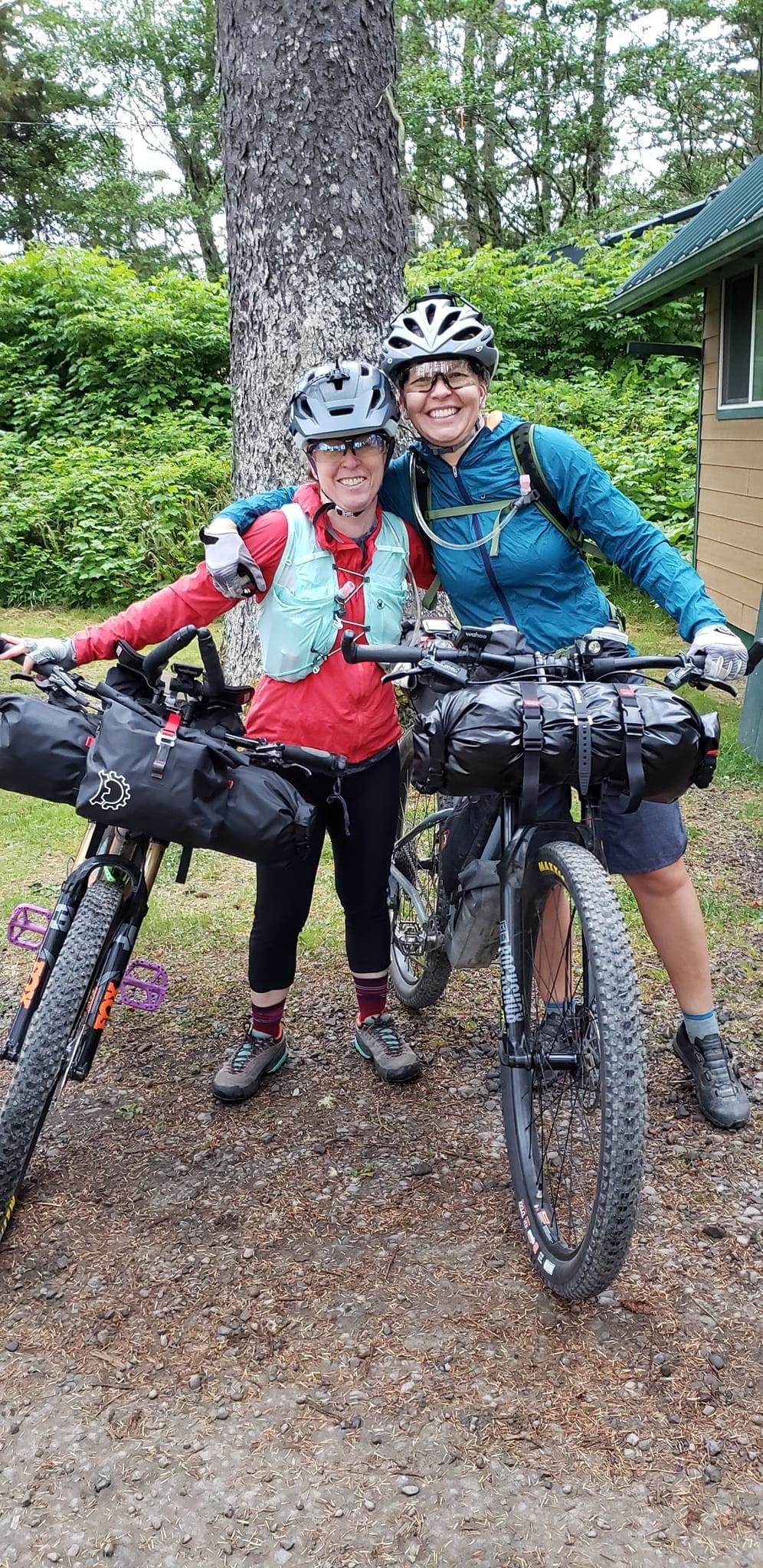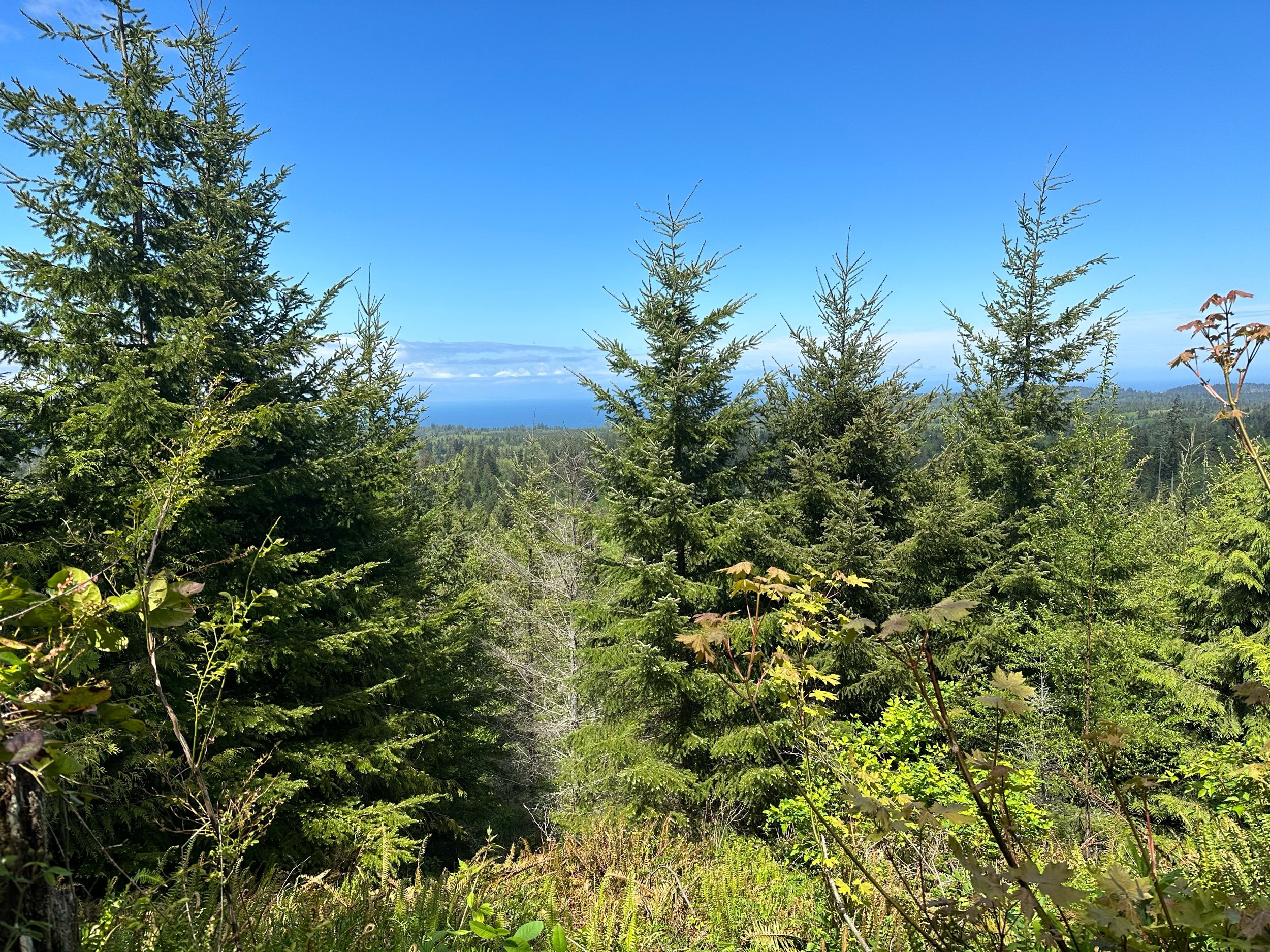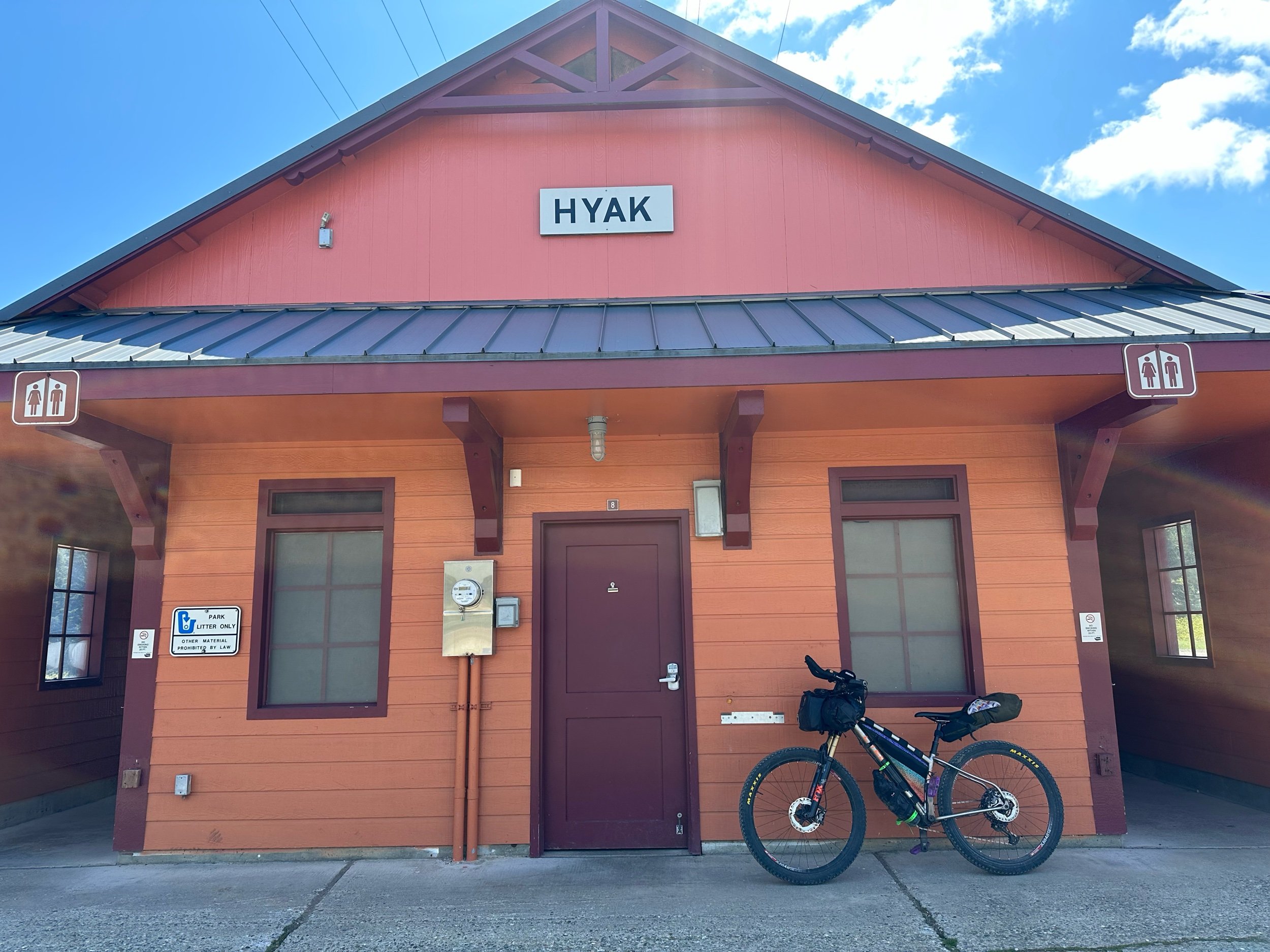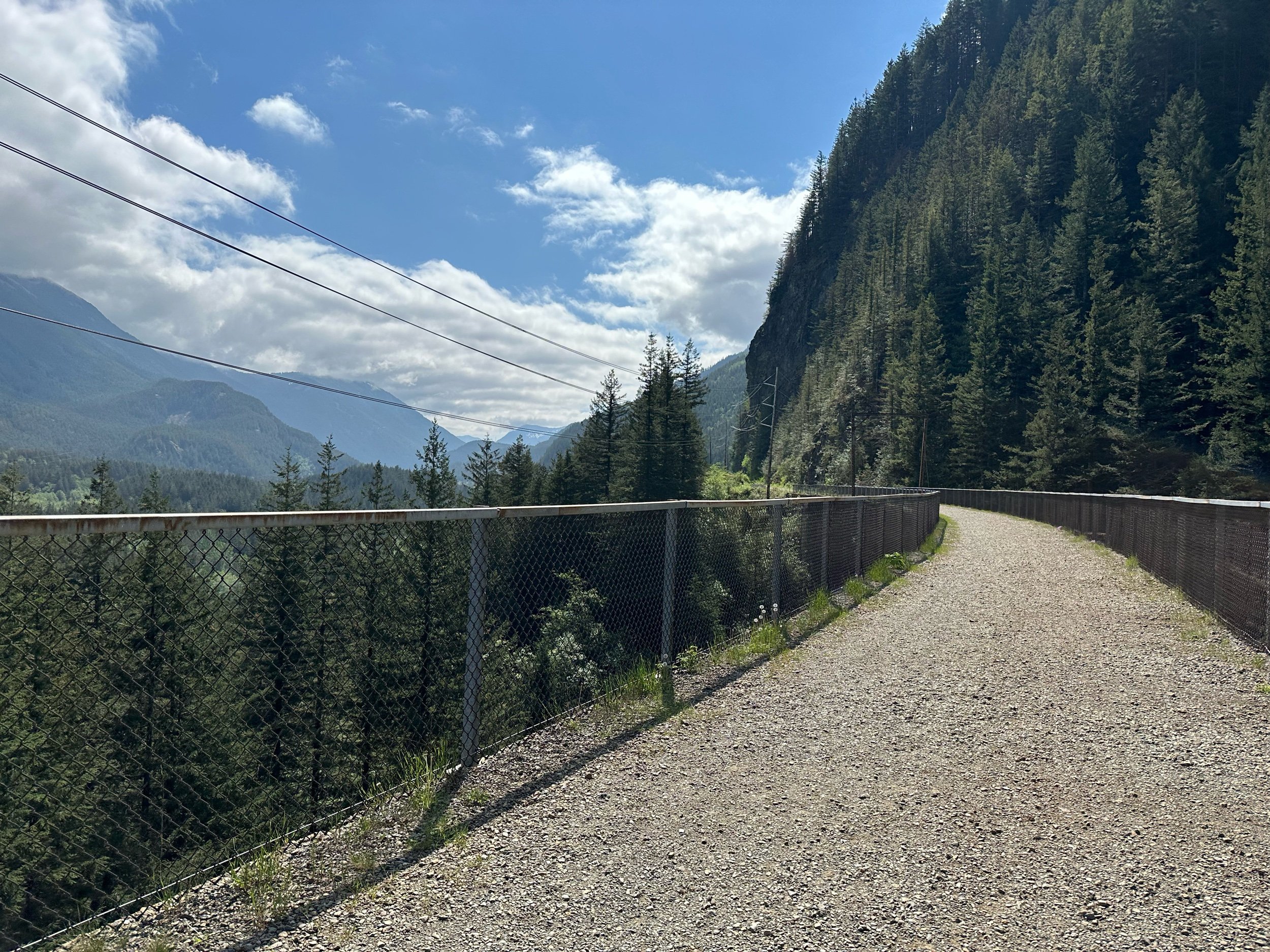Sarah’s 2023 Cross-Washington
I started typing up a day-by-day summary of my Cross-Washington Mountain Bike Race (XWA) but by the time I got to day 3, I was boring myself to death. I realized that in pondering XWA over the last few weeks, my reflections were bubbling up in the form of observational nuggets as opposed to what I did on what day. So on that note I’m sharing here the things I learned, the mistakes I made, and any other tidbits that may or may not be of any value at some point to someone.
Grand departs are about much more than “racing.”
After more than 25 years of participating in running, triathlon, and cycling races on both pavement and dirt, I lost all desire to attempt to do anything at “race pace” a few years ago. It just held no appeal for me anymore. When bikepacking, I wanted only to tour. I wanted to be able to sit down for a meal and lollygag at beautiful vistas and talk leisurely with locals and take 8,000 photos of wildflowers. But a series of big life events last summer (I won’t be coy: a divorce and moving back to Washington) changed my outlook and goals on certain things and other forces of the universe converged and before I knew it, a giddy eagerness to line up for the XWA Grand Depart was percolating in me. I lined up on May 21 without the intention to be competitive. I don’t really have that gene anymore and don’t care where I place (I was always in the midpack anyway). There were lots of people there who would be digging deep, pushing as hard as they could to get to the finish as fast as possible. There were also lots of people like me who were just in it for fun.
When you line up at a grand depart, there are a bunch of other weirdos just like you and you are all in it together. At a race like XWA where many folks come back multiple times, it means a reunion of friends that start to feel like a big family. Having everyone out on the route together has all kinds of cool benefits: dot watchers following along and cheering you in person and on social media; trail angels offering support and knowing exactly who you are when you roll up and they greet you by name; warm welcomes from small businesses who have shifted operations slightly to help support riders. It means when you get to a town or store or coffee shop or campground or ferry, there are often other riders there and you get to chat and compare plans and stories and laugh and cry together. It means possibly leap frogging with the same riders all day long or riding with them and potentially ending up with a new friend or riding buddy. All of this is much less frequent or non-existent when touring, except on the most heavily trafficked routes. Lining up for a grand depart is about much more than “racing.”

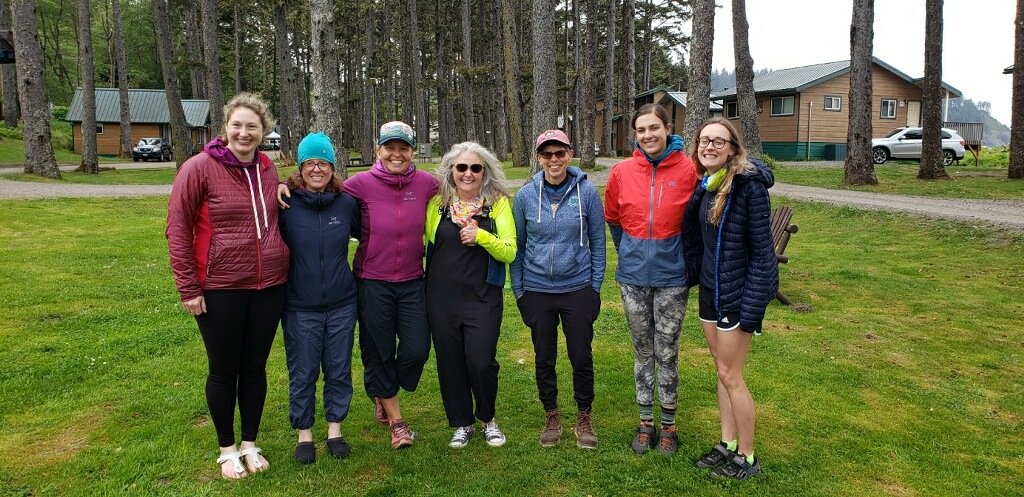
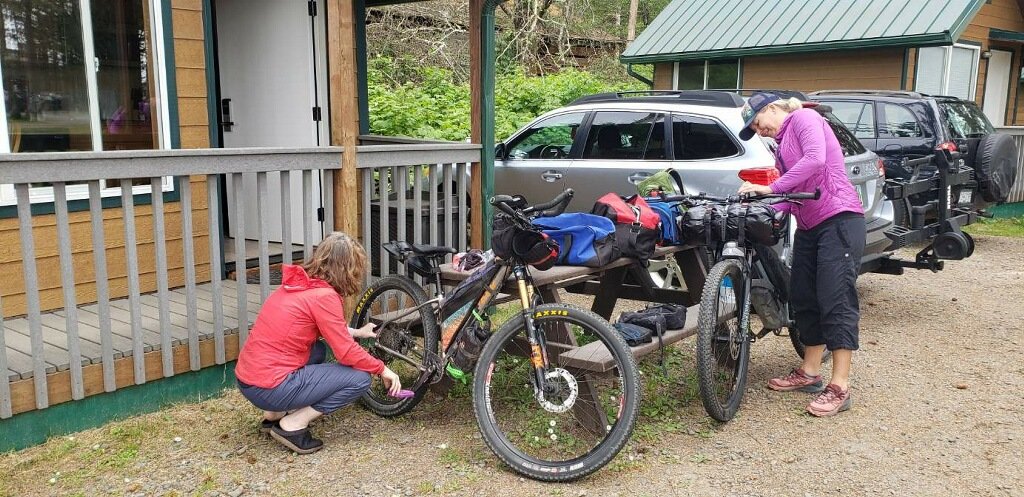
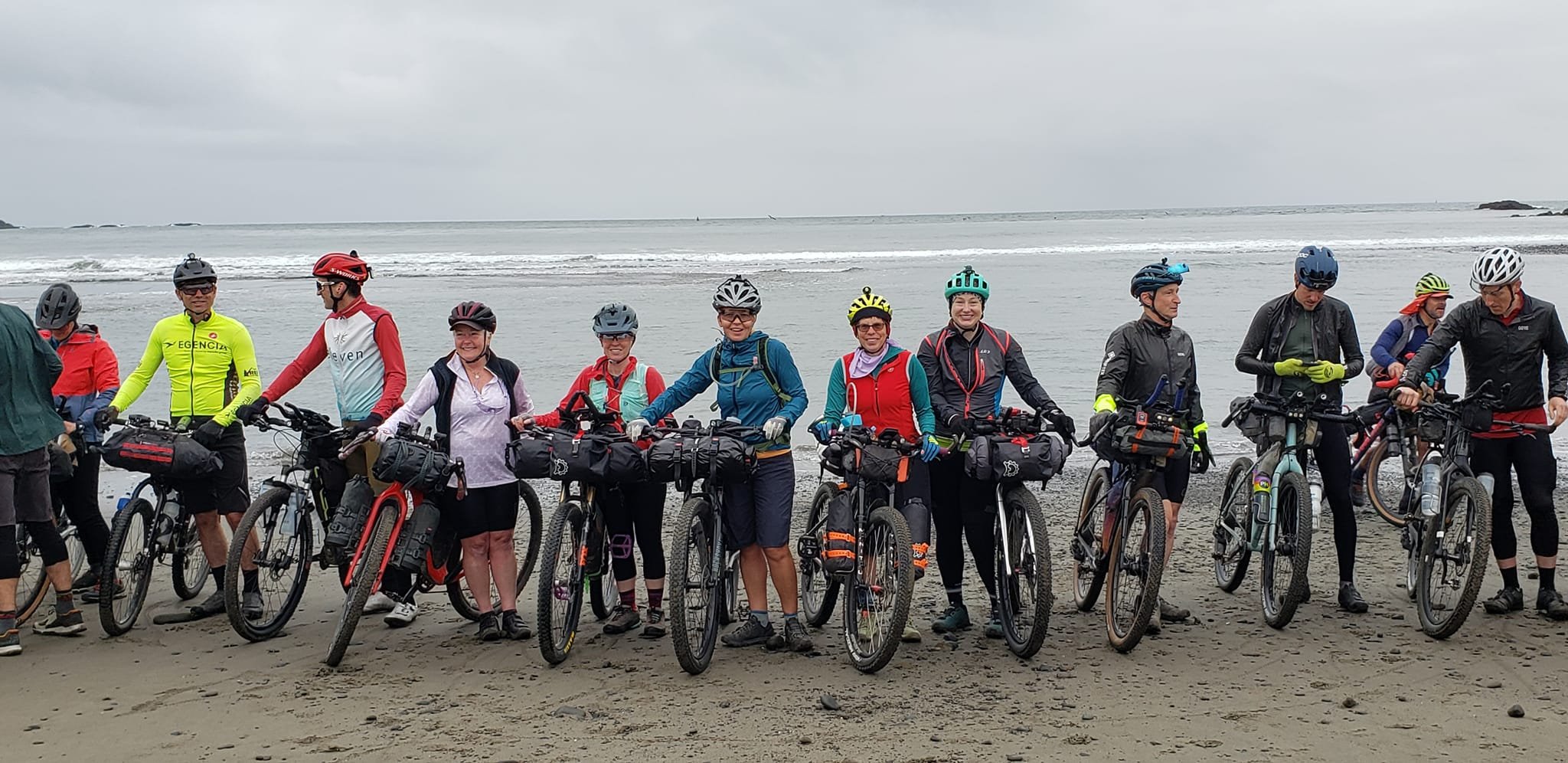

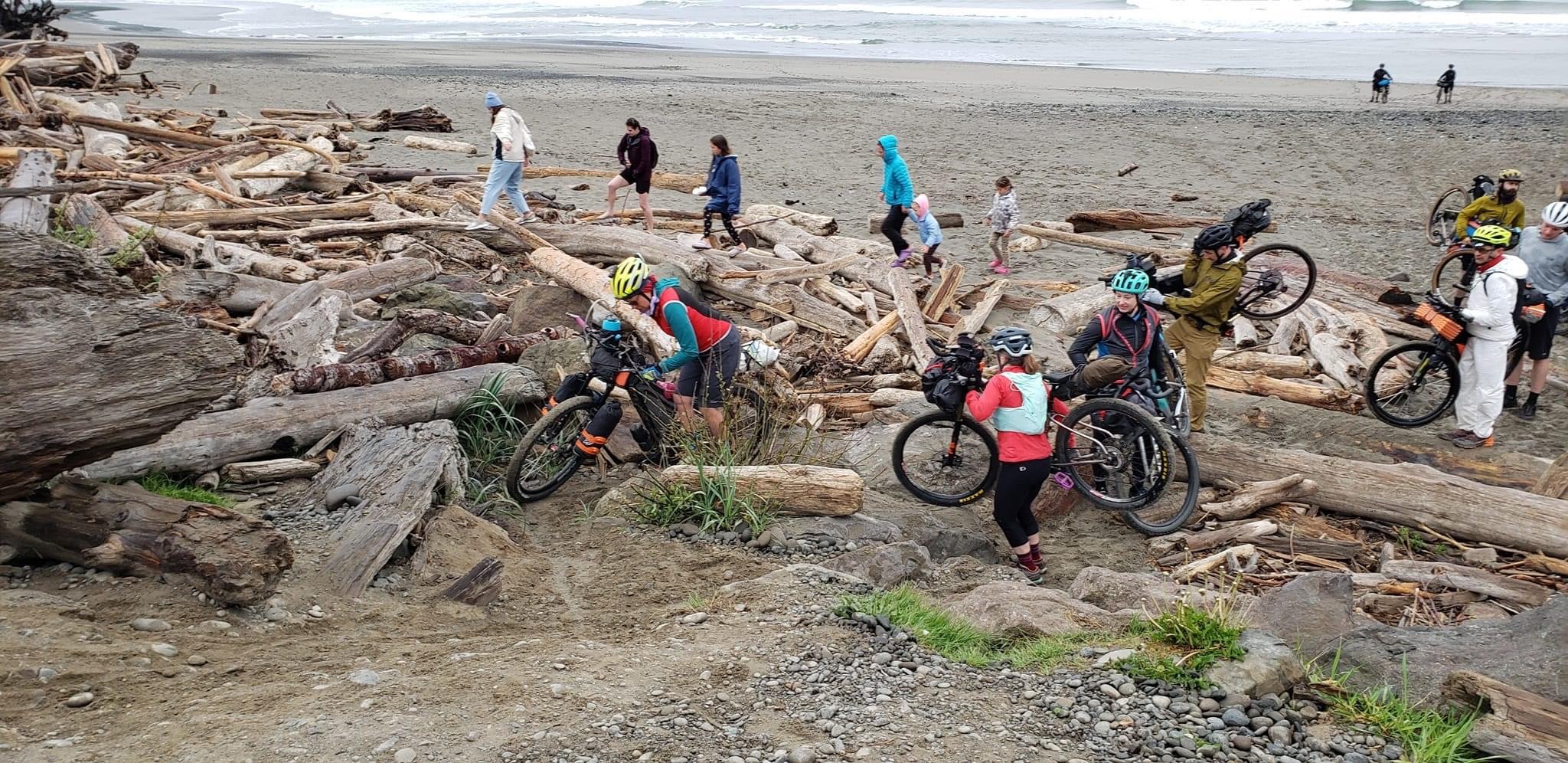
More women = better (duh).
There were seven women who lined up for the XWA this year which is five more than last year. Four of them (Irena, Annie Bilotta, Keri Bergere, and myself) were co-founders of the Washington Bikepacking Women group. Annie and Keri were the only two women to line up last year and they both finished and were both over 55! We sought out all seven women at the pre-race gathering so that we could say hello and chat for a bit. We gave each other good luck hugs and went about our races the next day.
Annie and Keri and I ended up leapfrogging for most of the first day and then sharing a hotel room in Port Angeles. Kiersten Rodriguez and I leapfrogged a bit the second day and then shared dinner and a campsite that night. When I DNFed, I went back out that day when Annie and Keri came through Cle Elum and cheered for them before we then went and got breakfast together. When Irena finished, her husband and I carpooled out to Tekoa to cheer for her and feed and care for her. About a week after everyone had finished, all of the Washington-based women who had lined up for XWA (Annie, Keri, Irena, Kiersten, Jo Lister, and I… Katya was on her way to the Tour Divide start line) met up for brunch at Annie’s house and almost three hours flew by as we compared stories about our XWA experiences with tons of laughter and joy.
Bikepacking is a sport that understandably induces fear in many (bears, cougars, hypothermia, crashes, and worse). Acknowledging and honoring those self-preserving fears, assessing which ones are keepers that are serving us vs those we’re comfortable trying to let go of, mitigating for safety to every extent possible, and proceeding through the fear to experience adventure can be life-changing. Experiencing this process of fear management with other women while you all are working your way through the learning curve together forges friendship bonds that are a true and rare treasure. The support we give each other is seemingly inexhaustible. I hope the sport of bikepacking continues to grow in a way that is welcoming to women and the other WBW ladies and I will do whatever we can to help speed up that process.
Being familiar with a route or the route-creator’s style is extremely helpful.
The joke in XWA lore is that Troy Hopwood, creator of the route, is an evil genius whose name is both cursed and revered many times over by each rider day after day while riding the route. He even jokes about it himself. Coming into the Port Ludlow old golf course area, there was a field with a mowed walkway to my left but the Wahoo track pointed straight. In the taller, unmowed grass straight ahead, I could just barely make out a strip where it appeared perhaps bikes had rolled through, flattening the grass. That was the correct route.
This perfectly sums up the XWA. If it seems like the track is sending you somewhere harder or weirder or less direct or not even really a trail, it’s probably right. Touring the route last year without awareness of evil genius intel made for many navigational snafus and chunks of time on the side of the trail using multiple mapping tools to figure out where to go. This year, I was able to remember some of those spots and knew the correct way to go. Much of the suburban segment was redesigned this year however so I didn’t have the advantage of experience there. Turns out that knowing Troy’s style when I found myself off-route made it much easier for me to scan the surroundings and make a solid educated guess at where I needed to go.
Bums and bits need training too.
It may sound obvious, but the skin of our saddle area needs just as much training as our muscles and respiratory system do. If we go into a long event undertrained (and therefore without a sufficiently seasoned leather taint, as my friend calls it), we should be prepared to manage potentially severe chafing issues. I knew this and was ready for it but I underestimated just how bad it would be. I kept it mostly tolerable with stupid amounts of a rotating blend of Aquaphor, Buttr, and Deez Nuts. In fact, I had so much lube that when I periodically tugged on my chamois to reposition it or pick a wedge, my fingers got coated in greasy slime. And my saddle itself looked like someone had drizzled oil over it. At night, I washed well and then applied Calmoseptine - a bedsore cream that I had been prescribed by a doctor in Helena when I had a big open saddle sore on the Great Divide. It is a miracle ointment. It is soothing and I swear helps stuff heal faster overnight. It’s available in most pharmacies without a prescription. I highly recommend that Calmoseptine be in any bikepacker’s quiver of personal care aids for longer distance trips. This routine made the whole situation tolerable, but barely.
Babying one injury can cause a brand new one.
I developed a knee injury in early February and had to take all of March completely off while I rehabbed it. I started testing it with some short Zwift rides in early April and tried riding outside starting on April 29. My knee was mostly ok as long as I followed my PT’s guidance to keep my heels down (i.e. not raised) through the whole pedal stroke and engage my glutes. It required a ton of concentration and focus but was doing the trick. And when I zoned out and let my form slip, my knee would start to ache which would prod me back into paying attention. I tried to quickly ramp up in the next 3 weeks and decided to still head out to La Push to line up for the XWA grand depart on May 21. My plan was to just take it day by day, knowing I may need to bail after a matter of hours or days. My knee held up great! But I was such an overachiever in forcing my heels down that I strained the ligaments on the front of my ankle and shin tendons to the point of excruciating pain by the middle of day 4. I couldn’t walk or put weight on it.
I got a hotel room in Ellensburg and called my PT. I iced and elevated my leg and took ibuprofen but in the morning there was no improvement — at all. The next section of the race was the Colockum which is remote, rugged, and requires a fair amount of hike-a-bike. I couldn’t even walk on that leg - how the heck was I going to HAB? Once I felt how bad it still was that morning, even after a night of rest and self-care, there was no question what the right move was. It would be completely idiotic, irresponsible, and possibly dangerous to continue. I emailed Troy that I was scratching and texted Irena’s husband who was in his truck coming to get me within 5 minutes (thanks again Justin). It would end up taking more than a week for the swelling to disappear completely and 10 days before I could walk normally again.
Riding into the night is simultaneously scary and liberating.
Historically, when I’m out for a ride or a run, once it starts getting dark, I feel an innate drive to get back to shelter. It feels (and probably is) primal. When Irena and I rode the Divide, we always aimed to have a planned sleeping spot well before dusk and started to feel uneasy if we didn’t. When I ran the Mountain Lakes 100 in 2018, I got the first taste of what it felt like to keep moving through the forest from dusk into darkness. I noticed that once I got past what I’ll call “the dusk hurdle,” the urge to return to shelter subsided and I was able to find ease and peace in the darkness. I began to cherish the silence of nighttime and how everything smells and looks and feels different.
It took a little longer to achieve this appreciation on the bike but it gelled on XWA this year. Knowing I had my bivy and could just stash myself pretty much anywhere, riding through the dusk hurdle was a mostly stress-free situation (with the exception of not knowing how long my old-ass headlamp battery would last but I’ve since rectified that by purchasing a new one). I’ve come to appreciate and actually seek out nighttime in the woods. It’s so peaceful. The stars on a clear night are mesmerizing. Laying in my bivy on night 3 looking up at the sky and falling asleep to an owl hooting brought a peace and grounding to my soul that is difficult to put into words. Part of this may be the exhilaration of liberation from fear. But I think it’s more likely that it’s tapping into something ancestral that we’ve lost - something that restores our connection with the earth and her ecosystems, a reintegration and mending of the separateness we’ve carved between us and her.
Bivy vs tent depends on lots of things.
I love my tent. I love having a shelter and bug-free zone where I can change clothes, eat food sitting up, and conduct whatever camp chores need doing. I went with a bivy for XWA though primarily because it is lighter, faster to set up/pack up, and offers much more flexibility for sleeping spots since it is low-profile and stealth. I was hopeful that I’d be able to ride long days and basically just make camp whenever I was ready to go to sleep. I loved being able to ride into the night knowing that all I needed for camp was a discreet, flat-ish spot the size of a mummy bag. It offered freedom and flexibility that the tent doesn’t. The trade-off is that if it’s raining or the mosquitoes are biting and you need to eat a meal or change clothing, you either have to do that while getting wet/bitten or try to do all of that from inside the bivy. It’s possible but can be a tight squeeze.
Bikepacking takes grit, and rain pants keep it out of your butt crack.
On day 1, it was drizzling all the way until just before Lake Crescent. I knew we’d be climbing for a while and I wasn’t cold so I decided to wait until the top of the climb out of Forks to put my rain pants on. That was a mistake. There was enough muddy spray and splatter that grit ended up in my chamois… which meant it was all up in my bits. Not a problem for a single short day ride but no bueno for a 12 hour day. At least three different times, I literally plucked out individual painful grains of dirt that were smooshed between my butt cheeks. How the hell did they even get in there? My jacket overlapped my shorts by inches and I’m pretty sure that when I stopped to pee, I wasn’t plunging my ass into a mud puddle. I don’t understand. But lesson learned.
By the way, for any fellow petite ladies reading this (I’m 5’0”), I want to plug my rain pants because I am so happy I finally found some where I don’t have to try to bunch up the extra length into a clumsy mess that threatens to get caught in the drivetrain (looking at you, Patagonia Houdini)… they are the 7Mesh Glidepath pant. They fit my shrimpy legs great and are super light but I do wish that they had a zipper on the cuff so I wouldn’t have to take my shoes off to put them on. Oh and I haven’t tested their mosquito-proof capabilities yet either. My rain pants must double as mosquito guards. If mosquitoes can bite through them, game over. I’ll come back and edit this when the verdict is in.
A cold dehydrated meal can be awesome.
I tried something new on this trip. I brought a Mountain House breakfast scramble and tortillas and I soaked it overnight in cold water since I didn’t bring a stove. The next morning, I put the scramble into a tortilla and ate it like a burrito while I rolled along the Snoqualmie Valley Trail. It was frickin delicious. And in case you did the math, yes I did carry that bag of scramble all the way from La Push to Carnation. It’s ok, they’re basically weightless.
Memory is not to be trusted after a certain point on a bikepacking trip.
Day 3 started from the campground in Quilcene and I was hoping to get all the way through the suburban segment that day. Arriving in Edmonds after the ferry ride, I was low on food and wanted to find a sandwich or burrito but was unsuccessful, mostly because I didn’t feel like wasting time poking around online to find a place and having to go off-route. My food calculus indicated that I had enough calories to get me to the PCC (a natural foods grocery store) in Redmond which I felt I’d be able to reach before they closed that evening. I had stopped there when I toured the route last year and was already salivating thinking about the delicious things I could buy for dinner and dessert. I made my way through the suburban segment as afternoon faded to evening and then nighttime. I was low on not just food but also water.
The PCC was supposed to be on the route at mile 90 for the day. Mile 90 came and went. I figured it was just GPS mileage calculation weirdness so I kept rolling. Then mile 95 came and went. At mile 100, I stopped and looked at my spreadsheet. In my memory, the PCC was right on the route. But there it was, in black and white on my spreadsheet: “PCC 0.3 mi off route”. Dammit! I did more quick calorie math and determined I was probably fine. I’d be going to sleep underfueled and a little dehydrated but not dangerously so. And silver lining: less likely to have to get up out of the bivy in the middle of the night to pee! I camped in a clear-cut area up above Tolt-MacDonald Park, used most of my remaining water to brush my teeth and rehydrate the aforementioned breakfast scramble, and rolled down into the park first thing in the morning to take advantage of the spigots there. If you’re wondering why I didn’t just go all the way to the park that night, there is a 2-night minimum for camping there and I’m too cheap to pay for two nights and only use one.
When it comes to bikepacking terrain, whatever is different is what I always seem to want.
I’m not sure how I never noticed this before but whatever terrain I’m on at a given moment, I’m usually looking forward to something different. When I’m on pavement, I can’t wait to get back on dirt and away from traffic. When I’m on singletrack, I can’t wait to be able to relax my bike handling focus by getting back on gravel. When I’m on gravel, I can’t wait for the smooth ease and speed of pavement. This was most palpable on XWA when I couldn’t wait to get past the suburban segment and all of its mandatory focus on complicated navigation and punchy climbs and just be able to zone out on the Snoqualmie Valley Trail. Then just a few miles into the SVT, I was bored senseless and my body felt twitchy, needing to switch up position and bend and flex. So, a note to my future self: try to settle in to the present, be happy where you are, and enjoy your surroundings. And on that note…
When the going gets tough, focus outward.
Looking back on especially days 3 and 4, when the pain in my leg was worsening, I was in my head for much of the day. I was stressed about the injury: What is the issue? Will it go away? Should I try stretching? Will stretching make it worse? Why is it swollen? Should I try taping it? Should I buy capsaicin cream? Are my electrolytes out of whack? Will I risk permanent damage if I continue? And on and on. As a result, I wasn’t present for the actual riding I was doing. I was focused inward, forming plans and strategies and then backup plans and strategies and then repeatedly questioning all of them. There’s no way that directing mental energy in that fashion helps the situation. So in the future, when things start to get painful, I need to make a plan A and plan B and then let it go. I need to remember to take in the sights, sounds, and scents of my surroundings. After all, these surroundings are one of the reasons I love bikepacking so much — immersing myself in nature and taking in all of the beauty and energy it has to offer.
That about sums it up!
I hope some of this will prove to be of use to someone out there or at the very least, perhaps possibly mildly entertaining. Will I line up for XWA again? Probably, if my schedule allows. We live in the most incredibly ecologically and geologically interesting state and riding all the way across it allows you to experience all of this in such a special way. My fellow Washington Bikepacking Women founders and I would love to see the numbers of women at the grand depart each year keep going up. My hope is that something in this here little post will prove to be helpful or (stretch goal!) inspirational in supporting and encouraging more women to consider giving it a go. If you do, we’ve got you.
Daily stats on my truncated 2023 XWA:
Day 1: La Push to Port Angeles. 94 miles / 7,293 feet.
Day 2: Port Angeles to Quilcene. 70 miles / 8,392 feet.
Day 3: Port Angeles to Carnation. 104 miles / 9,239 feet.
Day 4: Carnation to Ellensburg. 101 miles / 2,982 feet.
Here is my gear list for this year’s XWA.
